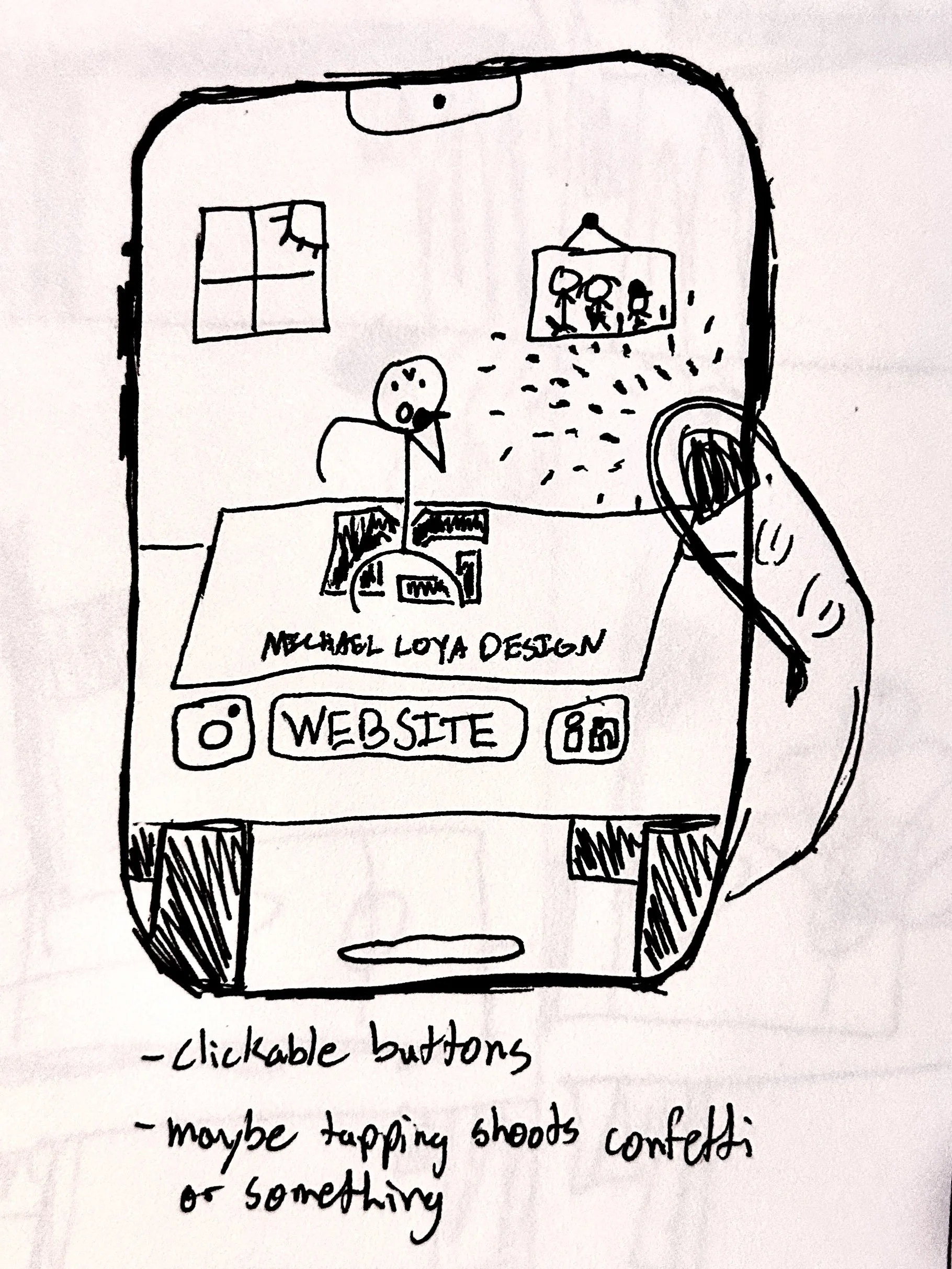AR BUSINESS CARD
For my augmented reality (AR) business card, I set out to create an interactive experience that went beyond a standard introduction. Using 8th Wall Niantic Studio, I explored the world of augmented reality design, learning how to integrate motion, 3D elements, and user interaction seamlessly. I also experimented with Ready Player Me to develop a personalized avatar and used DeepMotion AI for motion capture, bringing a new level of realism to the project.
Beyond AR, this project also allowed me to refine my skills in music production. Applying techniques from my record production class, I built a cleaner and more effective vocal chain in FL Studio using only stock plugins—balancing frequencies with EQ, tightening dynamics with compression, and adding subtle depth through delay, reverb, and widening. The final result is a dynamic, multimedia business card that blends technology, music, and design into an engaging and personal introduction.
Ideation and sketches for AR experience.
I began the ideation process by considering my two biggest hobbies—sports and music—and brainstorming ways to integrate them into an interactive AR experience. My first concept revolved around basketball, where my business card would serve as the court, and my avatar would dunk on a hoop that emerged from the ground. While this idea was exciting, I quickly realized the technical limitations of 8th Wall would make execution difficult, leading to long load times and a clunky user experience. Wanting something more seamless, I shifted my focus to music. Producing music has been a creative outlet for me, and incorporating it into the project felt like the perfect way to showcase not only my design skills but also my range as a creator. This direction allowed me to craft a business card that felt more personal, dynamic, and engaging.
With my concept in place, I moved on to creating my avatar using Ready Player Me. Initially, I experimented with Avaturn to generate a more realistic model, but its high-quality details and larger file size caused performance issues in 8th Wall, making it impractical. After finalizing my avatar, I wrote a short 8-bar rap about my design skills, which I’ll elaborate on later. To bring the performance to life, I recorded myself rapping on video, which I then used for motion capture in DeepMotion AI. While the results were solid, they weren’t flawless—some of my movements didn’t translate perfectly, and my arms occasionally clipped into my body. Moving forward, I’d focus on keeping my arms further from my torso and ensuring better contrast between myself and the background to improve tracking accuracy.
Motion capture using a Ready Player Me avatar and DeepMotion AI.
Basic vocal chain.
FL Studio project timeline.
Okay I’m back up on your screen you must be looking for design
See you got my business card or you just scanned it from online
Either way I’m bouta tell you how you found the right guy
I do everything creative from the visuals to the rhymes
Video production, I need no introduction
I float on the Creative Cloud man that’s cloud nine
Whatever I’m constructing, is ready for consumption
You need anything creative come to Michael Loya Design
Right here, yuh
For the rap production, I was inspired by a beat my brother, loya (see Sound & Vision), had sent me. He shares everything he makes, and this one immediately caught my ear. To start writing, I used an app called Rhymer’s Block, which suggests rhymes for every word you type. It’s a useful tool, but it can put you in a box if you rely on it too much, so I made sure to use it with caution. Since DeepMotion only allowed short video clips, I had to keep my rap concise—8 bars was the most I could fit while still making it flow naturally. Once I had the lyrics down (included to the left), I recorded my vocals over the beat and built a vocal chain using stock plugins in FL Studio. I used an EQ to cut the low end and slightly boost the highs, added compression for balance, slight reverb, a touch of delay, and some widening for depth. To bring more energy to the track, I layered in doubled vocals, ad-libs, and sound effects before mixing and mastering everything. It was a fun, creative challenge that tied my love for music and design together in a unique and engaging way.
8th Wall and Final Result
Bringing my business card into Blender, I modeled it as a 3D object and imported it into 8th Wall. Since I had only used the platform once before, there was still a learning curve. One major challenge was timing—the user has to accept multiple pop-ups before the experience fully loads, so I had to add delays to the animations to ensure everything played out smoothly. Figuring out how to trigger the rap animation was another obstacle. 8th Wall didn’t allow me to limit the tap action to a single instance, meaning if the user tapped more than once, it would spawn an army of avatars and completely break the experience. Unfortunately, there wasn’t a perfect fix, so I had to rely on instructions for the user to tap the card only ONCE. The end result isn’t the most intuitive interaction, but I think it does its job—showcasing my passion, creativity, and technical problem-solving while giving potential clients or employers a unique way to experience my work firsthand.












